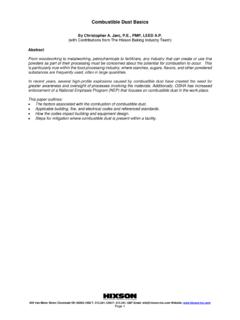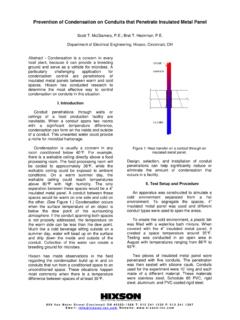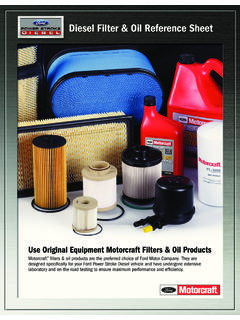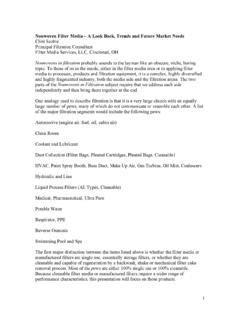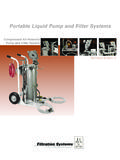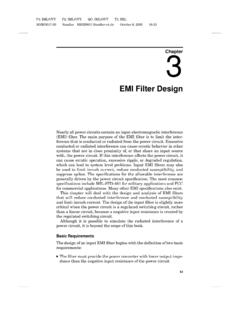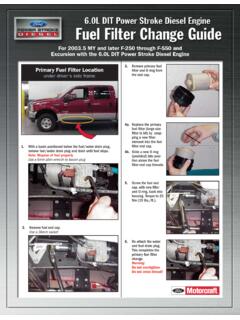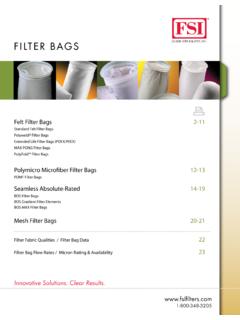Transcription of HVAC Filter Selection and MERV Ratings: What …
1 HHVVAACC FFiilltteerr SSeelleeccttiioonn aanndd MMEERRVV RRaattiinnggss:: WWhhaatt DDooeess IItt AAllll MMeeaann?? 659 Van Meter Street Cincinnati OH 45202-1568 T: 513 241 1230 F: 513 241 1287 Email: Website: 1By David Klenk, Mechanical Engineer In 1968, American Society of Heating, Refrigerating and Air Conditioning Engineers (ASHRAE) created Standard to test air filters using established techniques employed by the National Bureau of Standards and the Air Filter Institute.
2 During the course of the past 40 years, this standard has been modified several times to reflect changing air filtration testing requirements. The version in use today, Standard , evaluates filters based upon three key measurements: Arrestance. Designated as a percentage, the arrestance of the Filter , or ability of a Filter to remove synthetic dust, is calculated based upon the known weight of dust fed into a test unit under controlled conditions and the amount of weight added or captured by the Filter .
3 Atmospheric Dust Spot Efficiency. Designated as a percentage, two procedures can be used to calculate dust spot efficiency, which is the ability of a Filter to remove atmospheric dust from the air. Both the intermittent flow method and the constant flow method rely upon white Filter paper as a target and the ratio of light transmission. Sampling of atmospheric air is conducted at 25%, 50%, and 75% of dust loading and at final resistance. Efficiency is determined by an equation that incorporates total airflow through the upstream and downstream targets and opacity of dust spot on the upstream and downstream targets.
4 Traditionally, engineers and designers have used the terms 30%, 60%, and 85% filters to indicate which type of Filter to install. These terms refer to the dust spot efficiency of the filters. Dust Holding Capacity. Expressed in grams, dust holding capacity measures the amount of dust that a Filter can hold. Synthetic test dust is fed into a Filter and the final capacity is based upon the amount of dust held by the Filter . Standard does not evaluate particle size and efficiency of the Filter for a particular particle. It is not known what type and size of particles will be captured by the Filter .
5 For instance, a 30% Filter (based on arrestance) means that 30% of the weight of the dust has been captured. Depending on the size of the dust particles the actual number of particles (and hence the percentage of particles) captured may be substantially less. merv Defined To address the issue of particle size, ASHRAE was issued in 1999 and modified in 2007 to complement, not replace, Standard , by enabling engineers/designers to select a Filter based upon the actual known particle size of the contaminant desired to Filter .
6 Standard indicates the lowest point of Filter efficiency (which is normally right at the time of installation1). Filters are evaluated based upon initial efficiency as a function of one of 12 possible particle size ranges. Based on this data, a numerical value is assigned to a Filter . This numerical value is designated as merv : Minimum Efficiency Reporting Value. merv ratings are based upon specific airflow speeds which must be noted on the manufacturer s data. 1 Note that synthetic filters are typically electrostatically charged and will have a greater efficiency at time of installation but will lose efficiency quickly as the charge is dissipated.
7 ASHRAE currently does not address the dissipation of the electric charge. Refer to the Filter manufacturer literature or ask your local representative to determine if a Filter is electrostatically charged. HHVVAACC FFiilltteerr SSeelleeccttiioonn aanndd MMEERRVV RRaattiinnggss:: WWhhaatt DDooeess IItt AAllll MMeeaann?? 659 Van Meter Street Cincinnati OH 45202-1568 T: 513 241 1230 F: 513 241 1287 Email: Website: 2 High Efficiency Particulate Air (HEPA) Filters Six types of high-efficiency filters are available; however only Type A filters are typically used in GMP facilities.
8 1. Type A filters. Commonly known as Industrial Grade, Type A filters are used for GMP/industrial processing, hospitals, and non-critical areas. Unlike the other Filter types described below, which are tested both at the manufacturing facility and after installation, Type A filters are tested at the manufacturing facility only. 2. Type B filters. Commonly known as Nuclear Grade, these filters are used for Department of Energy nuclear programs (test reactors, R & D, and weapons) and commercial reactors. 3. Type C filters.
9 Commonly known as Laminar Flow Grade, Type C filters are used for laminar flow work stations, clean rooms, semiconductor and drug manufacturers. 4. Type D filters. Commonly known as Very Large Scale Integrated (VLSI) filters, these filters are used for semiconductor and drug manufacturers. 5. Type E filters. Commonly known as Bio/Hazard Grade, Type E filters are used for hazardous biological containment facilities. 6. Type F filters. Commonly known as Ultra Low Penetration Air (ULPA) Grade, these filters are used at semi-conductor facilities.
10 HEPA Filter efficiencies are based upon m particle sizes. Testing for merv merv ratings are created using the following testing process: 1. Initial resistance versus airflow is measured. 2. An optical particle counter measures and counts the particles in 12 equally distributed particle size ranges before and after the Filter . 3. ASHRAE test dust is introduced to the Filter in five predetermined steps (pressure drop across Filter increases by water gauge ( ), 25% of manufacturer s recommended final pressure drop, 50% of manufacturer s recommended final pressure drop, 75% of manufacturer s recommended final pressure drop and 100% of manufacturer s recommended final pressure drop).
